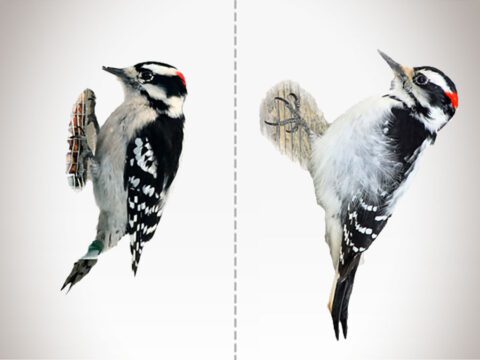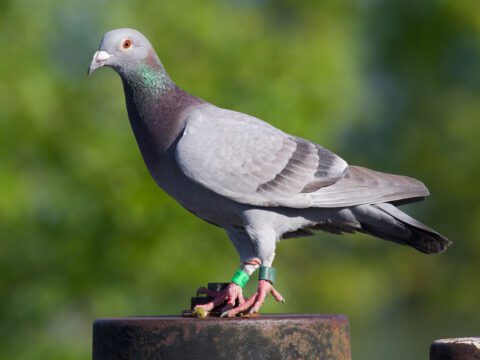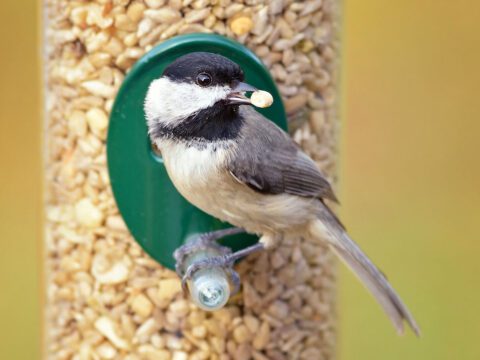Sound from the Field: Intruder at the Nest Box!
By Jon Erickson March 16, 2010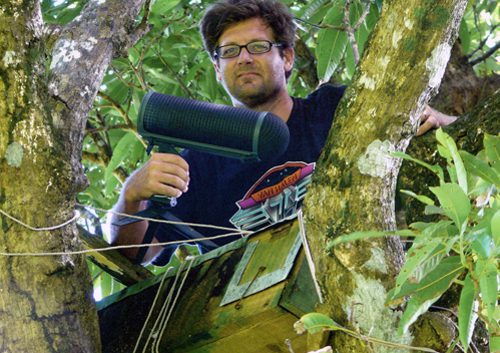
Jon Erickson is still roaming Mauritius with his microphone, making recordings of the tropic island’s unusual species. That’s him above, installing a microphone to record sounds at a Mauritius Kestrel nest in January. Here’s his story of the day’s work, including an alarming surprise encounter:
I’d spent so much time out among the seabirds of Round Island that the Mauritius Kestrel breeding season was nearly over, but I still hoped to find a juvenile to record. The kestrel nest I had visited early on had finished, but a Ph.D. student named Sam was studying another nest at Ferney Valley, on the east side of the island. She agreed to let me come along.
The sugarcane fields at Ferney blended into the surrounding hillside in a nearly blinding shade of green. Small rivers crossed the path as I made my way up into the hillside toward the kestrel nest. Mauritius fruit bats the size of crows flew above me, and the air was perfumed with flowers and a faint smell of molasses from the sugarcane.
The nest box sat on a branch about 15 feet high in a large tree beside a small river. A picturesque waterfall just 40 feet away would normally be so noisy that it would ruin my recordings, but fortunately I was prepared. I’d brought with me a pair of microphones that, when used together and placed close to the nest box, can capture a very realistic audio picture without the loud white noise of the waterfall.
Just then Sam arrived and kindly offered to haul my equipment up into the tree and while she checked on the young kestrels in the box. She scaled the tree effortlessly and peered into the box to find that one nestling had fledged but the other was still inside—possibly the last non-fledged kestrel chick on the island.
I tested my levels and found that the microphones in the tree were working brilliantly. But after a while with no visits, I started to wonder if my presence was keeping the adults away. I moved my gear to a hidden spot a bit farther away and, as it turned out, missed a very interesting development that I would learn about later.
As I sat down to record again I spotted a kestrel returning to the tree. Its green and brown leg bands marked it as the newly fledged juvenile. Next, the adult male returned to the tree with a fresh kill, and I was happy to hear the juvenile’s chattering coming in clearly over the microphones. In time, the female adult arrived and the three began milling about from branch to branch and occasionally calling. Neither adult approached the nest box.
Suddenly a very loud squawking came over my headphones. I had turned up the gain to catch the adults as they moved away from the microphones by the nest box, and now something was calling from inside the box and nearly deafening me.
Besides the volume, the call made me uneasy. I thought I recognized it, but not as a kestrel. I shrugged it off and continued recording the adults, with no further calls coming from inside the box. Still the adults did not approach the nest box. Maybe the bulky microphones were scaring them off, I thought, and decided to take them down. I would not get recordings of adults feeding the chick in the box, but it was at a critical moment in its development and needed to eat.
I scaled the tree using wooden handholds the researchers had placed. I unstrapped the microphones and peeked into the nest box. It took my brain several seconds to comprehend what I was seeing. There was a large mass of white feathers—a White-tailed Tropicbird was inside the kestrel nest—and its yellow beak was grabbing hold of the chick! The bird must have sneaked into the nest while I was moving my equipment, and that had been the shrill call I had heard earlier.
Hear the tropicbird screeching from inside the nest box:
Before I could free the kestrel chick, the tropicbird tumbled out of the nest with the chick in its beak. They fell about five feet before the white-tail let go and dropped the kestrel onto the rocks below. Stunned at what I had just seen, I climbed down and examined the bird. It lay on its back on the rocks with one of its wings resting in an awkward position.
Not sure how to proceed, I called Sam on my cell phone. She had moved on to another study site and was out of range, so I tried Rich, another member of the Mauritian Wildlife Foundation kestrel team, who told me to take the nestling to the M.W.F. station on the other side of the island.
I carefully placed the poor bird into a cloth bag, hiked out of the valley and drove to Rich. The bird was okay, but had suffered a damaged wing. It was taken immediately to the M.W.F. aviary to recover. (Here’s a picture of the bird safe in its cloth bag.)
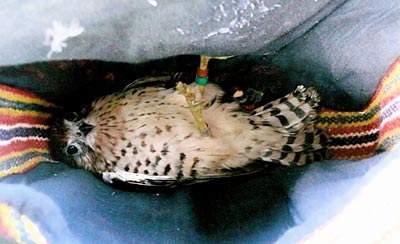
Later, Sam told me that it is not uncommon for tropicbirds to remove kestrel chicks from nests in order to take over the nest box. This particular nest box had a history of White-tailed Tropicbird encounters, she said. On more than one occasion, tropicbirds have been found inside of kestrel nests with a dead chick lying on the ground below it—but, to Sam’s knowledge, no one had ever witnessed the event.
Fortunately for this chick, I had. As of late February, the chick was doing fine at the aviary, and the team was considering releasing the bird back into the wild.
And on top of it all, I had collected a unique and unusual set of recordings.

All About Birds
is a free resource
Available for everyone,
funded by donors like you
American Kestrel by Blair Dudeck / Macaulay Library


